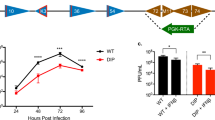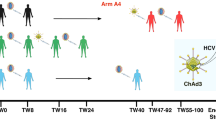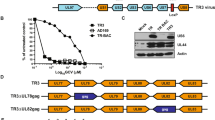Abstract
For leukemia vaccine generation, high-efficiency gene transfer is required to express immunomodulatory molecules that stimulate potent antileukemic immune responses. In this context, herpes simplex virus type-1 (HSV-1)-derived vectors have proven to be a promising tool for genetic modification of lymphoblastic leukemia cells. Yet, vector-associated viral protein expression might inadvertently modulate vaccine efficacy facilitating both immune evasion and immune stimulation. To explore the issue of immune-stimulation versus immune-suppression in immature lymphoblastic leukemia cells, two types of HSV-1 amplicon vectors, helper virus-dependent and helper virus-free that express the immunomodulatory molecules CD70 and IL-2, were compared with regard to their vector-associated immunomodulatory potential. We first established that lymphoblastic cell lines and primary acute lymphoblastic leukemia (ALL) cells express HSV receptor genes. Lymphoblastic cell lines were transduced with high efficiency, and in primary ALL cells high gene transfer rates of 47±15 and 42±14% were obtained with helper virus-dependent and -free HSV-1 amplicon vectors, respectively. The efficacy of the two amplicon vectors to induce antineoplastic responses was assessed in a vaccine setting in mice with pre-existing highly malignant lymphoblastic disease. Treatment of mice with vaccine cells transgenically expressing CD70+IL2 significantly suppressed lymphoblastic cell proliferation and improved survival. Of note, when helper virus-dependent HSV-1 amplicon vectors were used for vaccine preparation, the high immunogenic potential of the vector itself, in the absence of transgenic CD70+IL2 expression, seemed to be sufficient to mediate protection comparable to the antineoplastic response achieved by expression of immunomodulatory molecules. Thus for vaccine generation in B lymphoblastic leukemia, the immunogenic potential of HSV-1 helper virus-dependent amplicon vectors does provide additional benefit to the high transduction efficiency of HSV-1-derived vectors.
This is a preview of subscription content, access via your institution
Access options
Subscribe to this journal
Receive 12 print issues and online access
$259.00 per year
only $21.58 per issue
Buy this article
- Purchase on Springer Link
- Instant access to full article PDF
Prices may be subject to local taxes which are calculated during checkout










Similar content being viewed by others
References
Glorioso JC, Mata M, Fink DJ . Therapeutic gene transfer to the nervous system using viral vectors. J Neurovirol 2003; 9: 165–172.
Whitley RJ . Herpes simplex viruses. In: Knippe D, Howley R (eds). Virology. Lippincott Williams & Wilkins: Philadelphia, PA, 2001, pp 2461–2509.
Dilloo D et al. A novel herpes vector for the high-efficiency transduction of normal and malignant human hematopoietic cells. Blood 1997; 89: 119–127.
Kutubuddin M et al. Eradication of pre-established lymphoma using herpes simplex virus amplicon vectors. Blood 1999; 93: 643–654.
Tolba KA et al. Development of herpes simplex virus-1 amplicon-based immunotherapy for chronic lymphocytic leukemia. Blood 2001; 98: 287–295.
Sena-Esteves M, Saeki Y, Fraefel C, Breakefield XO . HSV-1 amplicon vectors – simplicity and versatility. Mol Ther 2000; 2: 9–15.
Dilloo D et al. Combined chemokine and cytokine gene transfer enhances antitumor immunity. Nat Med 1996; 2: 1090–1095.
Dunussi-Joannopoulos K, Weinstein HJ, Arceci RJ, Croop JM . Gene therapy with B7.1 and GM-CSF vaccines in a murine AML model. J Pediatr Hematol Oncol 1997; 19: 536–540.
Nakazaki Y et al. Vaccine effect of granulocyte-macrophage colony-stimulating factor or CD80 gene-transduced murine hematopoietic tumor cells and their cooperative enhancement of antitumor immunity. Gene Therapy 1998; 5: 1355–1362.
Stripecke R et al. Combination of CD80 and granulocyte-macrophage colony-stimulating factor coexpression by a leukemia cell vaccine: preclinical studies in a murine model recapitulating Philadelphia chromosome-positive acute lymphoblastic leukemia. Hum Gene Ther 1999; 10: 2109–2122.
Vereecque R et al. Gene transfer of GM-CSF, CD80 and CD154 cDNA enhances survival in a murine model of acute leukemia with persistence of a minimal residual disease. Gene Therapy 2000; 7: 1312–1316.
Herold BC et al. Glycoprotein C-independent binding of herpes simplex virus to cells requires cell surface heparan sulphate and glycoprotein B. J Gen Virol 1994; 75 (Part 6): 1211–1222.
Spear PG et al. Heparan sulfate glycosaminoglycans as primary cell surface receptors for herpes simplex virus. Adv Exp Med Biol 1992; 313: 341–353.
Geraghty RJ et al. Entry of alphaherpesviruses mediated by poliovirus receptor-related protein 1 and poliovirus receptor. Science 1998; 280: 1618–1620.
WuDunn D, Spear PG . Initial interaction of herpes simplex virus with cells is binding to heparan sulfate. J Virol 1989; 63: 52–58.
Montgomery RI, Warner MS, Lum BJ, Spear PG . Herpes simplex virus-1 entry into cells mediated by a novel member of the TNF/NGF receptor family. Cell 1996; 87: 427–436.
Mauri DN et al. LIGHT, a new member of the TNF superfamily, and lymphotoxin alpha are ligands for herpesvirus entry mediator. Immunity 1998; 8: 21–30.
Warner MS et al. A cell surface protein with herpesvirus entry activity (HveB) confers susceptibility to infection by mutants of herpes simplex virus type 1, herpes simplex virus type 2, and pseudorabies virus. Virology 1998; 246: 179–189.
Spaete RR, Frenkel N . The herpes simplex virus amplicon: a new eucaryotic defective-virus cloning-amplifying vector. Cell 1982; 30: 295–304.
Saeki Y et al. Herpes simplex virus type 1 DNA amplified as bacterial artificial chromosome in Escherichia coli: rescue of replication-competent virus progeny and packaging of amplicon vectors. Hum Gene Ther 1998; 9: 2787–2794.
Stavropoulos TA, Strathdee CA . An enhanced packaging system for helper-dependent herpes simplex virus vectors. J Virol 1998; 72: 7137–7143.
Horsburgh BC et al. Allele replacement: an application that permits rapid manipulation of herpes simplex virus type 1 genomes. Gene Therapy 1999; 6: 922–930.
DeLuca NA, McCarthy AM, Schaffer PA . Isolation and characterization of deletion mutants of herpes simplex virus type 1 in the gene encoding immediate-early regulatory protein ICP4. J Virol 1985; 56: 558–570.
Barcy S, Corey L . Herpes simplex inhibits the capacity of lymphoblastoid B cell lines to stimulate CD4+ T cells. J Immunol 2001; 166: 6242–6249.
Samady L et al. Deletion of the virion host shutoff protein (vhs) from herpes simplex virus (HSV) relieves the viral block to dendritic cell activation: potential of vhs-HSV vectors for dendritic cell-mediated immunotherapy. J Virol 2003; 77: 3768–3776.
Fruh K et al. A viral inhibitor of peptide transporters for antigen presentation. Nature 1995; 375: 415–418.
Ring CJ . Cytolytic viruses as potential anti-cancer agents. J Gen Virol 2002; 83: 491–502.
Eling DJ et al. Chronic lymphocytic leukemia B cells are highly sensitive to infection by herpes simplex virus-1 via herpesvirus-entry-mediator A. Gene Therapy 2000; 7: 1210–1216.
Hill A et al. Herpes simplex virus turns off the TAP to evade host immunity. Nature 1995; 375: 411–415.
Schwartz RH, Mueller DL, Jenkins MK, Quill H . T-cell clonal anergy. Cold Spring Harb Symp Quant Biol 1989; 54 (Part 2): 605–610.
Trentin L et al. B lymphocytes from patients with chronic lymphoproliferative disorders are equipped with different costimulatory molecules. Cancer Res 1997; 57: 4940–4947.
Tsukada N et al. The heterogeneous expression of CD80, CD86 and other adhesion molecules on leukemia and lymphoma cells and their induction by interferon. J Exp Clin Cancer Res 1997; 16: 171–176.
Guinn BA, DeBenedette MA, Watts TH, Berinstein NL . 4-1BBL cooperates with B7-1 and B7-2 in converting a B cell lymphoma cell line into a long-lasting antitumor vaccine. J Immunol 1999; 162: 5003–5010.
Dilloo D et al. CD40 ligand induces an antileukemia immune response in vivo. Blood 1997; 90: 1927–1933.
Goodwin RG et al. Molecular and biological characterization of a ligand for CD27 defines a new family of cytokines with homology to tumor necrosis factor. Cell 1993; 73: 447–456.
Hintzen RQ et al. Characterization of the human CD27 ligand, a novel member of the TNF gene family. J Immunol 1994; 152: 1762–1773.
Kobata T et al. CD27 is a signal-transducing molecule involved in CD45RA+ naive T cell costimulation. J Immunol 1994; 153: 5422–5432.
Brown GR, Meek K, Nishioka Y, Thiele DL . CD27–CD27 ligand/CD70 interactions enhance alloantigen-induced proliferation and cytolytic activity in CD8+ T lymphocytes. J Immunol 1995; 154: 3686–3695.
Hintzen RQ et al. Engagement of CD27 with its ligand CD70 provides a second signal for T cell activation. J Immunol 1995; 154: 2612–2623.
Couderc B et al. Enhancement of antitumor immunity by expression of CD70 (CD27 ligand) or CD154 (CD40 ligand) costimulatory molecules in tumor cells. Cancer Gene Ther 1998; 5: 163–175.
Lorenz MG, Kantor JA, Schlom J, Hodge JW . Anti-tumor immunity elicited by a recombinant vaccinia virus expressing CD70 (CD27L). Hum Gene Ther 1999; 10: 1095–1103.
Zibert A et al. Leukemia cells transduced with HSV-1 amplicons expressing CD70 and IL-2 stimulate a protective anti-leukemic immune response. Blood 2000; 96: 804a.
Matzinger P . An innate sense of danger. Semin Immunol 1998; 10: 399–415.
Toda M et al. Immuno-viral therapy of brain tumors by combination of viral therapy with cancer vaccination using a replication-conditional HSV. Cancer Gene Ther 2002; 9: 356–364.
Huang AY, Bruce AT, Pardoll DM, Levitsky HI . In vivo cross-priming of MHC class I-restricted antigens requires the TAP transporter. Immunity 1996; 4: 349–355.
Huang AY et al. Role of bone marrow-derived cells in presenting MHC class I-restricted tumor antigens. Science 1994; 264: 961–965.
Vile RG et al. Generation of an anti-tumour immune response in a non-immunogenic tumour: HSVtk killing in vivo stimulates a mononuclear cell infiltrate and a Th1-like profile of intratumoural cytokine expression. Int J Cancer 1997; 71: 267–274.
Todryk S et al. Disabled infectious single-cycle herpes simplex virus as an oncolytic vector for immunotherapy of colorectal cancer. Hum Gene Ther 1999; 10: 2757–2768.
Ali SA et al. Preclinical evaluation of ‘whole’ cell vaccines for prophylaxis and therapy using a disabled infectious single cycle-herpes simplex virus vector to transduce cytokine genes. Cancer Res 2000; 60: 1663–1670.
Tolba KA et al. Herpes simplex virus (HSV) amplicon-mediated codelivery of secondary lymphoid tissue chemokine and CD40L results in augmented antitumor activity. Cancer Res 2002; 62: 6545–6551.
Kim KJ et al. Establishment and characterization of BALB/c lymphoma lines with B cell properties. J Immunol 1979; 122: 549–554.
Glimcher LH, Kim KJ, Green I, Paul WE . Ia antigen-bearing B cell tumor lines can present protein antigen and alloantigen in a major histocompatibility complex-restricted fashion to antigen-reactive T cells. J Exp Med 1982; 155: 445–459.
Johnson PA et al. Cytotoxicity of a replication-defective mutant of herpes simplex virus type 1. J Virol 1992; 66: 2952–2965.
Smith IL, Hardwicke MA, Sandri-Goldin RM . Evidence that the herpes simplex virus immediate early protein ICP27 acts post-transcriptionally during infection to regulate gene expression. Virology 1992; 186: 74–86.
Geller AI, Keyomarsi K, Bryan J, Pardee AB . An efficient deletion mutant packaging system for defective herpes simplex virus vectors: potential applications to human gene therapy and neuronal physiology. Proc Natl Acad Sci USA 1990; 87: 8950–8954.
Bergold PJ, Casaccia-Bonnefil P, Zeng XL, Federoff HJ . Transsynaptic neuronal loss induced in hippocampal slice cultures by a herpes simplex virus vector expressing the GluR6 subunit of the kainate receptor. Proc Natl Acad Sci USA 1993; 90: 6165–6169.
Saeki Y et al. Improved helper virus-free packaging system for HSV amplicon vectors using an ICP27-deleted, oversized HSV-1 DNA in a bacterial artificial chromosome. Mol Ther 2001; 3: 591–601.
Geschwind MD, Kessler JA, Geller AI, Federoff HJ . Transfer of the nerve growth factor gene into cell lines and cultured neurons using a defective herpes simplex virus vector. Transfer of the NGF gene into cells by a HSV-1 vector. Brain Res Mol Brain Res 1994; 24: 327–335.
Levitsky HI et al. Immunization with granulocyte-macrophage colony-stimulating factor-transduced, but not B7-1-transduced, lymphoma cells primes idiotype-specific T cells and generates potent systemic antitumor immunity. J Immunol 1996; 156: 3858–3865.
Zibert A et al. CCL3/MIP-1alpha is a potent immunostimulator when coexpressed with interleukin-2 or granulocyte-macrophage colony-stimulating factor in a leukemia/lymphoma vaccine. Hum Gene Ther 2004; 15: 21–34.
Acknowledgements
We thank D Klostermann for excellent technical assistance. The work was supported by the multicenter grant of the German National Ministry for Research and Technology ‘Strategies for Somatic Gene-Transfer’ (Research alliance of the university medical centers ‘Düsseldorf, Essen, Halle; Coordinator: U Göbel), project 4 ‘Cytokine and Chemokine Gene-Transfer into Malignant Hematopoietic Cells for the Generation of a Leukemia Vaccine’ and the Elterninitiative Kinderkrebsklinik Düsseldorf e.V.
Author information
Authors and Affiliations
Rights and permissions
About this article
Cite this article
Zibert, A., Thomassen, A., Müller, L. et al. Herpes simplex virus type-1 amplicon vectors for vaccine generation in acute lymphoblastic leukemia. Gene Ther 12, 1707–1717 (2005). https://doi.org/10.1038/sj.gt.3302577
Received:
Accepted:
Published:
Issue Date:
DOI: https://doi.org/10.1038/sj.gt.3302577



